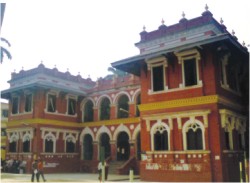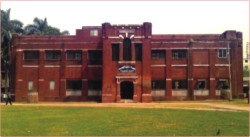Feature
Rajshahi College reaches 137 years
Shams Biswas
 RAJSHAHI College was the first educational institute in Bangladesh to award the Bachelors of Honours and Masters Degree. It is one of the oldest higher educational institutes in Bangladesh. It is said to be the third oldest college in Bangladesh after Dhaka College (Established 1841) and Chittagong College (Established1869). The college started on 1 April 1873. RAJSHAHI College was the first educational institute in Bangladesh to award the Bachelors of Honours and Masters Degree. It is one of the oldest higher educational institutes in Bangladesh. It is said to be the third oldest college in Bangladesh after Dhaka College (Established 1841) and Chittagong College (Established1869). The college started on 1 April 1873.
The history of the college is related with the name Bawlia English School (later Rajshahi Collegiate School). As an education city, the foundation of Rajshahi mega city was laid through the establishment of the private English school, Bawlia English School in 1828. This very small institute became famous as the pathfinder in the history of modern education in East Bengal. Mainly the school was established with a view to expanding English educational infrastructure by the initiative of English officials along with the citizens of Rajshahi. In 1836 the school was taken over by the provincial government of Bengal and was converted into a Government Zila (or District) School. Again, through the concerted efforts and appeals of local citizens, the Zila school was given the status of an Intermediate College. In 1872, Raja Haralal Roi Bahadur of Dubalhati donated land for the establishment of the college and the annual income from the property was around Rupees 5,000.
Within a short period after establishment, the college became one of the main centres of higher education for the people of East Bengal, North Bengal, Bihar, Purnia and Assam. The FA (Fine Arts) classes of the college started on 1 April 1873 on the premises of the Rajshahi Zila School. The first batch of students included only six boys and one of them was from the Muslim community. The college counted 100 in 1878, 200 in 1900, 400 in 1910, and 800 in 1920 and no fewer than 1000 students in 1924; there was only one Muslim student in the college in 1873. Five years later it was still one, but the figure rose to 156 in 1916 and 215 in 1924. Subsequently, the number of Muslim students rose in the college and after 1947 eventually exceeded the Hindu students. The number of students reached to 1000 in 1930 and in the next year the college started taking girl students. In 1970, the college had 1,840 students, of whom about 300 were girls. The college vastly expanded after the independence of Bangladesh and in 1990, the number of students was 4,732, of whom 1,352 were girls. The enrolment increased to about 8,000 in 2000. In 2009, the number of students is about 23,000.
The first principal of the college was Haragobinda Sen, who was the Headmaster of Rajshahi Zila School. He served the college for five years (1873-1878). Roi Kumudini Kanta Banerjee (Bahadur, M.A, I.E.S.) while serving the college as principal (May 1897-Nov 1924) contributed a lot to its development. The 23rd principal Prof. Dr. Momtaj Uddin Ahamed (1945-1950) is the first principal who came from the Muslim community. The present principal Prof. Dr. Ali Reza Mohammed Abdul Mojid is the 55th principal of the college.
Of the first batch of students appearing in the FA examinations in 1875 only two passed. The government wanted to abolish the college but had to abandon the idea, thanks to the efforts of the Rajshahi Association, which rather pressed for transforming it into an upgraded college by introducing BA courses. The founding president of Rajshahi Association Raja Promothnath Roy Bahadur of Dhigapathia gave 150,000 rupees to the government through the Rajshahi Association for introducing Degree programme in the college. The college got affiliation for the Degree programme in October 1877. In 1878, this college was upgraded to 1st grade and B.A Course was started this year. At that time, MR. F.T. Dowding was the principal of this college.
 The Administrative building was constructed in 1884. The College's first hostel PN Hostel was built in 1894 by the Rajshahi Association. In 1902, Hemantakumari Hostel was built with the money of Hemantakumari, the Rani of Puthia. The Administrative building was constructed in 1884. The College's first hostel PN Hostel was built in 1894 by the Rajshahi Association. In 1902, Hemantakumari Hostel was built with the money of Hemantakumari, the Rani of Puthia.
The main administrative building is a good example of British Indian colonial architecture. Other important older buildings of the colonial period include the Fuller Hostel, Biology Building, Chemistry Building, Physics Building and former Muslim Hostel.
In 1904, the Moharani Hemantakumari Sanskrit College was established under the administration of Rajshahi College to provide Sanskrit teaching without tuition fee. Raja Krishnananda Hall of the college was built in 1910 with the financial assistance of Kumar Sharadindu Rai of Balihar. In 1915, the college authority constructed the Physics building at a cost of rupees 57,145. At the initiative of the Rajshahi Association and by the efforts of the Principal Roi Kumudini Kanta Banerjee a total of six hostels were built: five at a total cost of Rupees 3,53,863 in 1922 and a two-storied one at a cost of Rupees 78,000 in 1923. The Arts building was constructed in 1925-26 session at a cost of Rupees 86,809. In 1927, a residential house for the Principal was built on the bank of the river Padma to the south of the college.
Gradually, other buildings were constructed on approximately 57.0694 acres of land.
In 1884, the Rajshahi Madrasah building was built on the college premises. The Mohammedan Fuller Hostel, built in 1909. The Basantakumar Agricultural Institute was established in 1936 under the Rajshahi College administration with the financial assistance of Kumar Basantakumar Roi of Dhigapathia. The institute closed down in 1952 and its building became a hostel of the college. Newer buildings include the Library and Auditorium, an Arts building, both dating from the 1950's and a new Science building, dating from the 1990's.
The college got affiliation for MA courses in 1881 and Bachelor of Law courses in 1883 from the Calcutta University. Within a few years, eight students earned their MAs and sixty students got their BL degrees from the Rajshahi College. In 1909, MA and BL courses were suspended because the college could not meet the requirements of the New Regulations of the Calcutta University, which came into force that year.
 In East Pakistan, the college was first affiliated with the University of Dhaka and later with the University of Rajshahi, which was established in 1953 (the university started from this college). Courses in I Com, B Com (Pass) and B Com (Honours) programmes were introduced in 1952, 1954 and 1961 respectively. In 1994, Masters level courses were re-introduced under affiliation with the National University. The college closed down the higher secondary level courses in 1996. In East Pakistan, the college was first affiliated with the University of Dhaka and later with the University of Rajshahi, which was established in 1953 (the university started from this college). Courses in I Com, B Com (Pass) and B Com (Honours) programmes were introduced in 1952, 1954 and 1961 respectively. In 1994, Masters level courses were re-introduced under affiliation with the National University. The college closed down the higher secondary level courses in 1996.
Rajshahi College teachers and students have contributed immensely to every political and social crisis of the nation. They participated in Swadeshi andolon. In the Language Movement after the killing of students in Dhaka on 21 February 1952, students in Rajshahi College built what is often thought to be the first (but short-lived), martyr monument dedicated to the Language Movement. The present monument to the Language Movement dates from 1973. It has been built to replace an earlier monument, built in 1969, that was destroyed by Pakistani forces in 1971. The teachers and students actively participated in the 1962 and 1969 student movements. In the Bangladesh Liberation War they joined in large numbers and fought with great courage and valour.
At present, the college offers three years Bachelors degree, four years Honours courses in 20 subjects and 21 Masters Courses. It has 241 teachers (Principal-01, Vice-principal-01, Professor-20, Associate Professor-57, Assistant Professor -80, Lecturer-82), 67 of whom are women. The college library is rich with many rare books, gazettes, encyclopaedias, manuscripts, and ancient puthi manuscripts. In 2009, the library has a collection of 73,000 books.
Rajshahi College now faces multifaceted problems. There is shortage of classrooms and exam halls. The old buildings need immediate repair. There is shortage of teachers. One of the most important problems is shortage of transports. There are only three buses (one is college's bus and other two are hired) for 23,000 students! Now Internet service is very important for study but there is no such facility for student.
On 1st April 1873, Rajshahi College had started its journey with only six students towards an unknown future. Gradually the college reached an admirable position by overcoming all uncertainty and obstacles. Today, in independent Bangladesh, the college has been accorded "University College" status. In its 137 years of journey, Rajshahi College has produced many brilliant personalities, but sadly enough people have forgotten to celebrate Rajshahi College anniversary with due festivity.
(Freelance cartoonist and 4th year student, Department of Management, Rajshahi College, Rajshahi)
|
